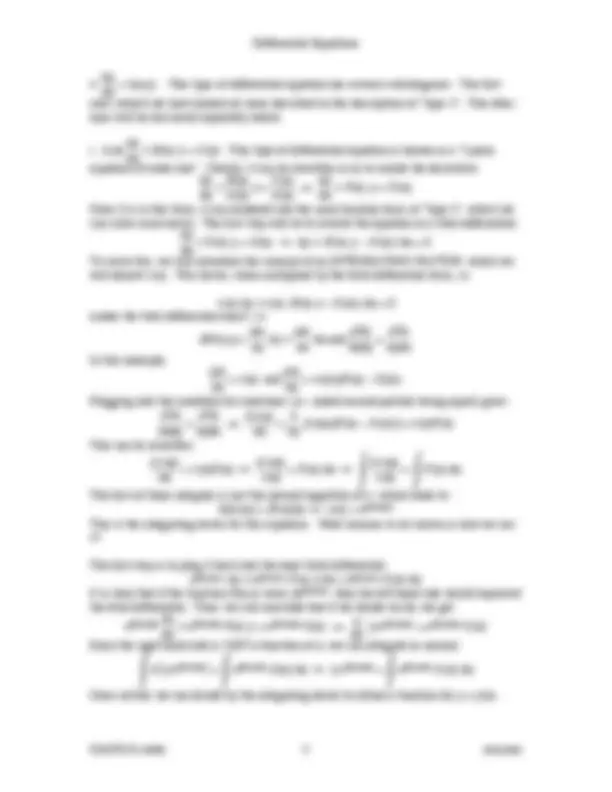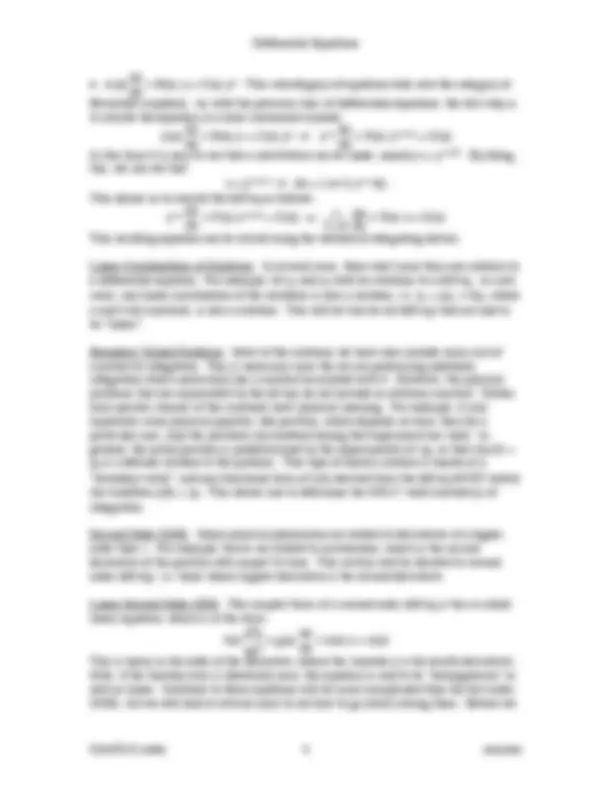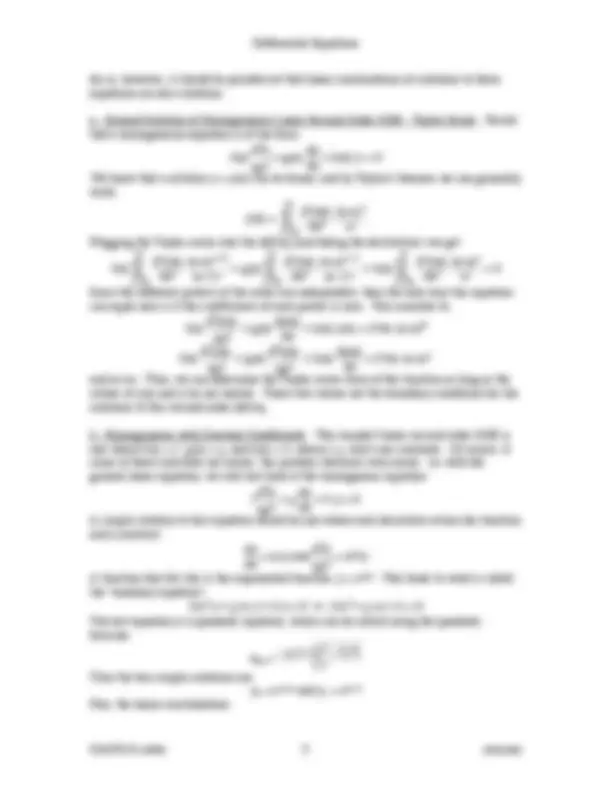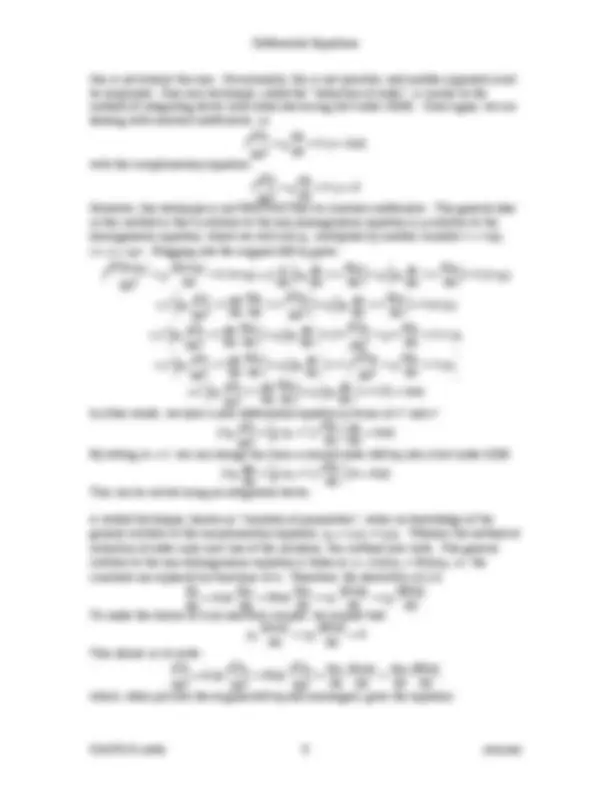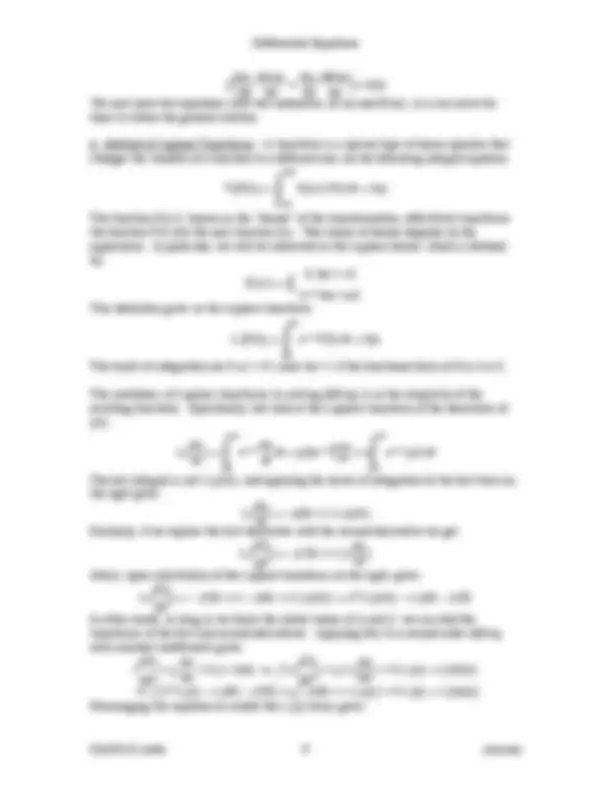Download Lecture Notes on Differential Equations | CHEM 4515 and more Study notes Chemistry in PDF only on Docsity!
Differential Equation: A differential equation is an equation that includes at least one derivative of an unknown function. These equations may include the unknown function as well as known functions of the same variable. The derivative may be of any order, and there may be several derivatives present. Generally speaking, a differential equation is a representation of a physical phenomenon, where the derivatives correspond to the "rates of change" of the unknown function with respect to the variable. The solution to a differential equation is the form of the unknown function that makes the differential equation into an identity. Classification of Diff.Eqs.: There are many terms used to describe a differential equation. The first is the order of the differential equation, which describes the highest order derivative in the equation. For example if we had the equation: d^3 y dx^3
- x d^2 y dx^2
- x^2 dy dx
- x^3 y = 0 the highest order derivative is d^3 /dx^3 , which makes this a "third ordered" diff.eq. It is often advantageous to rewrite the differential equation such that the highest order derivative is isolated. In our example this becomes: d^3 y dx^3 = – x d^2 y dx^2
- x^2 dy dx
- x^3 y = F(x, y, y', y") In other words, the highest order derivative is a function of the variable, in this case x, and all of the lower-ordered derivatives. Another important classification is that of linearity. If the unknown function and its derivatives are present to the first power ONLY, the diff. eq. is said to be linear. If any of them are present raised to a higher power, the diff. eq. is nonlinear. Note, the independent variable, x, may be present in any power without affecting the linearity. The degree of a differential equation is the power to which the highest ordered derivative is raised. The last classification of a diff. eq. is that of being ordinary or partial. If the derivatives are NOT partial derivatives, the diff. eq, is said to be ordinary. Conversely, if partial derivatives are present in the equation, it is said to be a partial differential equation. This distinction will become more obvious when we look at how to solve these equations. Solving Diff Eqs: Finding the differential equation that "models" the physical phenomenon is probably the most important problem. However, the solution to the diff eq, i.e. the function (i.e. a relationship between the variables) that satisfies the equation, is what we will be looking at in this section. To simplify the discussion, we will look at the different classes of diff eqs separately, starting with the simplest and building up to the more difficult. Solving diff eqs requires some expertise in integration as well as a good deal of intuition. Recognizing patterns often simplifies the work of solving the diff eq. First Order Ordinary Diff Eqs (ODEs): First order differential equations fall into several categories. They are given by the following equations:
dy dx = f(x) 2. dy dx = g(y)
dy dx = f(x)g(y) 4. dy dx = h(x,y) Each of these is slightly different, thus requires a slightly different technique to solve. We will look at each one individually.
dy dx = f(x) : This type of differential equation can be solved by direct integration of the function, i.e. y = ∫ f(x) dx. Since we have spent much time talking about integration, we will not spend any more time discussing this class of diff eqs.
dy dx = g(y) : Although this type of diff eq seems much more complicated than the previous one, it is very similar. The big difference is that the role of the two variables, x and y, have switched. The variable y is now the "independent" one, and x is the "dependent" one. To solve this, we rewrite the equation to reflect the new classifications, i.e. dy dx = g(y) ⇒ dx dy
g(y) = h(y) ⇒ x(y) = ∫ h(y) dy Once the equation of x as a function of y is generated, one can invert the classification again and generate y = y(x).
dy dx = f(x)g(y) : This is the first really "interesting" type of diff eq that we will see. Solutions of this type of diff eq require us to recognize that the equation can be rewritten as: dy dx = f(x)g(y) ⇒ f(x) dx = 1 g(y) dy ⇒ f(x) dx + G(y) dy = 0 where F(x) = 1/f(x) and G(y) = – 1/g(y). This last form indicates that the two variables can be treated separately, thus this technique is called "separation of variables". The solution to the equation will be of the form: f(x) dx = 1 g(y) dy Once the two integrals are evaluated a functional form of y= y(x) may be deduced. This type of differential equation is also related to the form: dy dx
f(x,y) g(x,y) ⇒ f(x,y) dx + g(x,y)dy = 0 where the functions are not of just one variable. Solutions to these types of equations require some of the techniques used in the line integral section of the course. Often, a substitution of variables, e.g. y = f(x,z), is required to allow for the proper solution. Examples of this will be given in the next section.
ii. A(x) dy dx
- B(x) y = C(x) yn^ : This subcategory of equations falls into the category of Bernoulli's equation. As with the previous class of differential equations, the first step is to rewrite the equation in a more convenient manner: A(x) dy dx
- B(x) y = C(x) yn^ ⇒ y– n^ dy dx
- F(x) y–n+1^ = G(x) In this form it is easy to see that a substitution can be made, namely z = y–n+1. By doing this, we can see that: z = y–n+1^ ⇒ dz = (–n+1) y– n^ dy This allows us to rewrite the diff eq as follows: y– n^ dy dx
- F(x) y–n+1^ = G(x) ⇒ 1 (1–n) dz dx
- F(x) z = G(x) This resulting equation can be solved using the method of integrating factors. Linear Combinations of Solutions: In several cases, there exist more than one solution to a differential equation. For example, let y 1 and y 2 both be solutions to a diff eq. In such cases, any linear combination of the solutions is also a solution, i.e. y 3 = a y 1 + b y 2 , where a and b are constants, is also a solution. This will be true for all diff eqs that are said to be "linear". Boundary Valued Problems: Most of the solutions we have seen include some sort of constant of integration. This is necessary since the we are performing indefinite integration which necessarily has a constant associated with it. However, the physical problems that are represented by the dif eqs do not include an arbitrary constant. Rather, only specific choices of the constants have physical meaning. For example, if y(x) represents some physical quantity, like position, which depends on time, then for a particular case, only the positions encountered during that experiment are valid. In general, the initial position is predetermined by the experimental set up, so that y(x=0) = y 0 is a definite solution to the problem. This type of known solution is known as a "boundary value", and any functional form of y(x) derived from the diff eq MUST satisfy the condition y(0) = y 0. This allows one to determine the ONLY valid constant(s) of integration. Second Order ODEs: Many physical phenomena are related to derivatives of a higher order than 1. For example, forces are related to acceleration, which is the second derivative of the position with respect to time. This section will be devoted to second order diff eqs, i.e. those whose highest derivative is the second derivative. Linear Second Order ODE: The simplest form of a second order diff eq is the so-called linear equation, which is of the form: f(x) d^2 y dx^2
- g(x) dy dx
- h(x) y = k(x) This is linear in the order of the derivative (where the variable y is the zeroth derivative). Note, if the function k(x) is identically zero, the equation is said to be "homogeneous" as well as linear. Solutions to these equations will be more complicated than the first order ODEs, but we will look at several cases to see how to go about solving them. Before we
do so, however, it should be pointed out that linear combinations of solutions to these equations are also solutions. a. General Solution of Homogeneous Linear Second Order ODE - Taylor Series: Recall that a homogeneous equation is of the form: f(x) d^2 y dx^2
- g(x) dy dx
- h(x) y = 0 We know that a solution y = y(x) can be found, and by Taylor's theorem we can generally write: y(x) = dny(a) dxn (x–a)n n!
n = 0 ∞ Plugging the Taylor series into the diff eq (and taking the derivatives) we get: f(x) dny(a) dxn (x–a)n– (n–2)!
n = 0 ∞
- g(x) dny(a) dxn (x–a)n– (n–1)!
n = 0 ∞
- h(x) dny(a) dxn (x–a)n n!
n = 0 ∞ = 0 Since the different powers of the series are independent, then the only way this equation can equal zero is if the coefficients of each power is zero. This amounts to: f(x) d^2 y(a) dx^2
- g(x) dy(a) dx
- h(x) y(a) = 0 for (x–a)^0 f(x) d^3 y(a) dx^3
- g(x) d^2 y(a) dx^2
- h(x) dy(a) dx = 0 for (x–a)^1 and so on. Thus, we can determine the Taylor series form of the function as long as the values of y(a) and y'(a) are known. These two values are the boundary conditions for the solutions to this second order diff eq. b. Homogeneous with Constant Coefficients: The simplest linear second order ODE is one where f(x) = f , g(x) = g , and h(x) = h. where f , g , and h are constants. Of course, if some of these constants are zeroes, the problem becomes even easier. As with the general linear equation, we will first look at the homogenous equation: f d^2 y dx^2
- g dy dx
- h y = 0 A simple solution to this equation would be one where each derivative return the function and a constant: dy dx = m•y and d^2 y dx^2 = m^2 •y A function that fits this is the exponential function, y = emx. This leads to what is called the "auxiliary equation": f m^2 y + g m y + h y = 0 ⇒ f m^2 + g m + h = 0 The last equation is a quadratic equation, which can be solved using the quadratic formula: m± =
- g ± g^2 – 4 f h 2 f Thus the two simple solutions are: y+ = em+x^ and y– = em–x Plus, the linear combinations:
c. Non-homogeneous Second Order Linear ODE: Now that we have a better feel for second order diff eqs, we can make the leap from homogeneous to non-homogeneous equations. The general form, of course is: f(x) d^2 y dx^2
- g(x) dy dx
- h(x) y = k(x) The related homogenous equation, i.e. when k(x) = 0, is called the "complementary" equation. The solution to the complementary equation is symbolized by yc, and we have briefly talked about it (i.e. the Taylor series solution). The general solution to the non- homogenous equation will necessarily include yc, as well as a "particular" solution, yp, which is one solution that definitely works. We will look at these solutions shortly. Simply said, the general solution will be y = yc + yp. This can be verified by plugging into the diff eq: f(x) d^2 (yc+ yp) dx^2
- g(x) d(yc+ yp) dx
- h(x) (yc+ yp) = f(x) d^2 yc dx^2
- g(x) dyc dx
- h(x) yc + f(x) d^2 yp dx^2
- g(x) dyp dx
- h(x) yp = 0 + k(x) Now that we are satisfied that y = yc + yp is a solution we will need to examine the particular solutions. c-i. Method of Undetermined Coefficients: This technique can be used for diff eqs with constant coefficients, i.e.: f d^2 y dx^2
- g dy dx
- h y = k(x) Note, the non-homogeneity (i.e. k(x)) need NOT be a constant. Of course, we know the solution to the complimentary equation, yc, from our discussion above. The particular solution is what we are interested in. To find it, we must treat the function k(x) as a particular solution to some OTHER homogeneous linear equation with constant coefficients. This may be of higher order than 2, i.e.: a dnk(x) dxn^
- b dn–1k(x) dxn–^
- ... + w dk(x) dx
- z k(x) = 0 Using the technique of auxiliary equations, we can generate the necessary roots, m': a m'n^ + b m'n–1^ + ... + w m' + z = 0 Finding this equation is the key to solving the problem. Once this differential equation is found, we can apply it to the non-homogeneous equation of interest: a d n dxn^ f d^2 y dx^2
- g dy dx
- h y + ... + w d dx f d^2 y dx^2
- g dy dx
- h y + z f d^2 y dx^2
- g dy dx
- h y = 0 Clearly, this can be rewritten as a linear ODE with constant coefficients of order n+2, which will have n+2 root, m". These roots will contain the original root m of the second order ODE and the roots m' of the k(x) equation. The general equation of the k(x) equation can be adjusted to fit the particular non-homogeneous equation we are trying to solve. And, if we have an initial condition, the exact form of the complementary solution can also be found. c-ii. Reduction of Order and Variation of Parameters: The technique above only works when k(x) IS a particular solution to a diff eq, AND we can find the diff eq. However,
this is not always the case. Occasionally, this is not possible, and another approach must be employed. One such technique, called the "reduction of order", is similar to the method of integrating factor used when discussing first order ODEs. Once again, we are dealing with constant coefficients, i.e. f d^2 y dx^2
- g dy dx
- h y = k(x) with the complimentary equation: f d^2 y dx^2
- g dy dx
- h y = 0 However, this technique is not RESTRICTED to constant coefficients. The general idea in this method is that a solution to the non-homogeneous equation is a solution to the homogeneous equation, which we will call yh, multiplied by another variable v = v(x), i.e. y = yhv. Plugging into the original diff eq gives: f d^2 (v•yh) dx^2
- g d(v•yh) dx
- h (v•yh) = f d dx yh dv dx
- v dyh dx
- g yh dv dx
- v dyh dx
- h v yh = f yh d (^2) v dx^2
- 2 dv dx dyh dx
- v d^2 yh dx^2
- g yh dv dx
- v dyh dx
- h v yh = f yh d (^2) v dx^2
- 2 dv dx dyh dx
- g yh dv dx
- f v d^2 yh dx^2
- g v dyh dx
- h v yh = f yh d (^2) v dx^2
- 2 dv dx dyh dx
- g yh dv dx
- v f d^2 yh dx^2
- g dyh dx
- h yh = f yh d (^2) v dx^2
- 2 dv dx dyh dx
- g yh dv dx
- v 0 = k(x) In other words, we have a new differential equation in terms of v" and v': f yh d (^2) v dx^2
- g yh + 2 f dyh dx dv dx = k(x) By letting w = v', we can change this from a second order diff eq into a first order ODE: f yh dw dx
- g yh + 2 f dyh dx w = k(x) This can be solved using an integration factor. A related technique, known as "variation of parameters", relies on knowledge of the general solution to the complimentary equation, yc = c 1 y 1 + c 2 y 2. Whereas the method of reduction of order only uses one of the solutions, this method uses both. The general solution to the non-homogeneous equation is taken as y = A(x)y 1 + B(x)y 2 , i.e. the constants are replaced by functions of x. Therefore, the derivative of y is: dy dx = A(x) dy 1 dx
- B(x) dy 2 dx
- y 1 dA(x) dx
- y 2 dB(x) dx To make the choice of A(x) and B(x) simpler, we require that y 1 dA(x) dx
- y 2 dB(x) dx
This allows us to write: d^2 y dx^2 = A(x) d^2 y 1 dx^2
dy 1 dx dA(x) dx
dy 2 dx dB(x) dx which, when put into the original diff eq and rearranged, gives the equation:
L{y} = L{k(x)} + ( g + s f )y(0) + f y'(0) f s^2 + g s + h To find y, all that remains is taking the "inverse transform" of this solution. Using a table of Laplace transforms and finding the one that best fits this solution accomplishes this.

